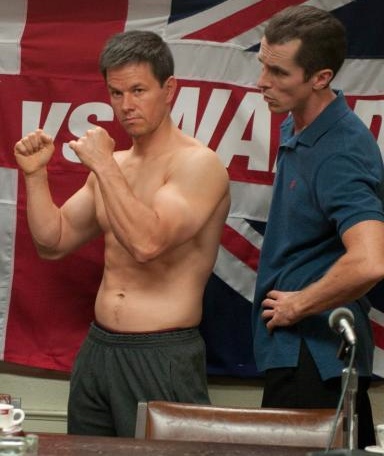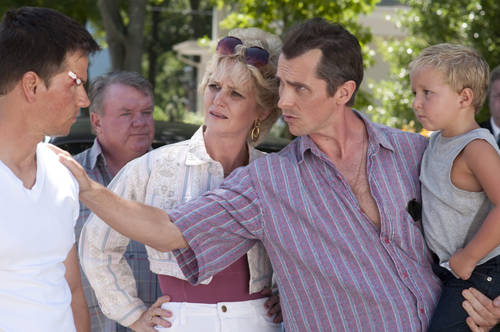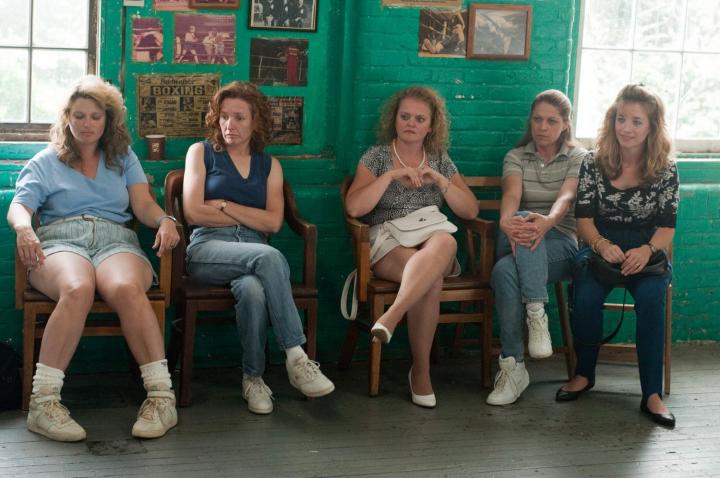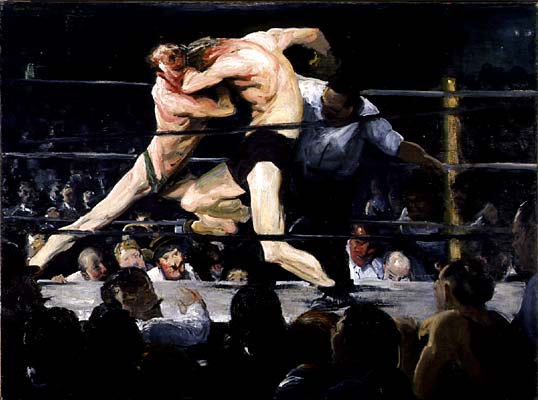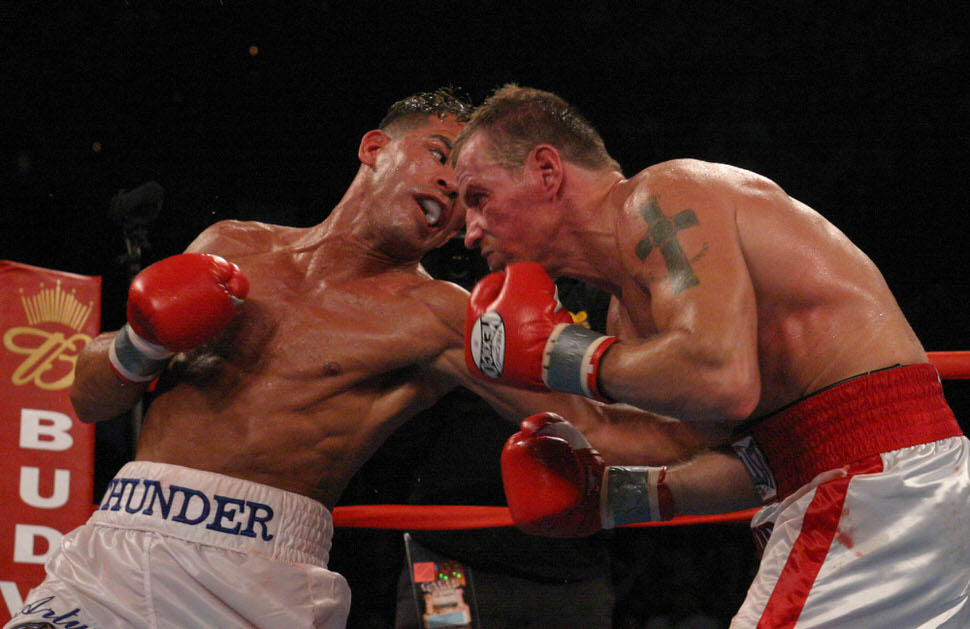The Fighter might more accurately have been titled The Fighter and His Family: it’s a boisterous, brilliantly orchestrated ensemble piece at the paradoxically near-still center of which is an Irish-American boxer (Mark Wahlberg), whose once-promising career, like his grim hometown, Lowell, Massachusetts, is on what appears to be an inevitable downward spiral. Just nominated for seven Academy Awards—including best picture and Christian Bale as supporting actor, the current favorite in that category—the film is based on the life and career of former junior welterweight champion Micky Ward, most famous for his three brutally hard-fought bouts with Arturo Gatti in 2002–2003. It is also a group portrait of working-class Irish-Americans in a blighted, postindustrial landscape: the brawling, clannish, emotionally combustible Ward-Eklund family for whom Micky is the great hope and from whom, if he wants to survive, let alone prevail as a boxer of ambition, he must separate himself.
In a sequence of sharply realized scenes, not unlike the rounds of a boxing match, The Fighter pits the Ward-Eklund matriarch Alice (Melissa Leo) and her favored son, ex-boxer Dicky (Christian Bale), the half-brother of Micky, against Mickey and his girlfriend Charlene (Amy Adams). The film traces a highly contentious, often darkly funny tug-of-war for Micky’s soul, which is to say his career. Like Micky, the viewer is made to experience the almost literally suffocating and coercive “love” of a family for its own—the heroic, if desperate, effort that an essentially nonrebellious son like Micky must make simply to be allowed to be an adult; though he’s at least thirty years old, divorced, with a young daughter from whom he’s separated, and, in his own words, he’s “not getting any younger.” (In professional boxing, most boxers are burned out by thirty and at risk of serious injury.)
Dramatizing the actual Micky Ward’s life, but only to a degree, The Fighter follows the archetypal pattern of the generic boxing film—see Cinderella Man (2005) as a recent example, as well as the cruder, more slickly produced Rocky films—in its modestly uplifting ending. The subjects of these films are not boxers of the quality of the young, dazzling Mike Tyson or the legendary Muhammad Ali, Sugar Ray Robinson, or Joe Louis but journeyman fighters who’ve managed through sheer effort to win just a little more often than they’ve lost. Poor Micky isn’t even, by nature, aggressive; he’s far from the “raging bull” counterpuncher Jake LaMotta of Martin Scorsese’s film, so desperate in his ring stratagems that even his victories have an air of the haphazard and the tentative.
By default, since he’s losing a crucial fight with the British boxer Shea Neary, Micky falls back upon the notorious strategy that brought Ali victory against George Foreman in the 1974 “Rumble in the Jungle” in Zaire: the “rope-a-dope” ploy in which the weaker boxer allows the stronger to literally punch himself out on the weaker boxer’s body through round after devastating round, until, as in an astonishing fairy-tale reversal of fortune, the “weaker” boxer knocks out the “stronger.” It’s a strategy that gave the thirty-two-year-old Ali an unexpected, historic victory against his twenty-five-year-old opponent, but certainly contributed to Ali’s physical deterioration, including the Parkinsonian condition that has afflicted him now for decades.
The effect of such a beating on the physically weaker Micky Ward may lie sometime in the future—The Fighter doesn’t come near suggesting the physical consequences of Micky’s fighting style. We never see a doctor examining poor Micky though, in fact, following even his victory against Gatti in 2002, he’d had to be hospitalized, as he was again following the punishing rematch fights with Gatti, both of which he lost. It’s a relief to the viewer to learn at the film’s end that Micky has retired from boxing—not a moment too soon.
In his portrayal of the talented but unexceptional athlete who makes of himself through dogged, diligent training a “champion”—if only junior welterweight—Mark Wahlberg is quietly convincing, the film’s anchor as he is the film’s core; his is a steady, stolid performance, subtly nuanced in the way of the young Al Pacino—a kind of “acting” indistinguishable from “real life.” By contrast—and the contrast is considerable—Christian Bale as Dicky Eklund, Micky’s half-brother and trainer, gives a tour de force performance, not unlike Joe Pesci’s in his first major film role as LaMotta’s manic brother Joey in Raging Bull. Dicky is a former boxer himself, whose single moment of glory is his having “knocked down” Sugar Ray Leonard years before in a match that Leonard won. Dicky is Micky’s trainer, when he manages to show up at the gym, clearly intelligent, shrewd, self-destructive and unreliable—a crack addict, yet charismatic—with the gaunt cheeks and sunken eyes of the doomed.
Advertisement
It’s a measure of Christian Bale’s brilliant performance that the viewer can’t look anywhere else when “Dicky” is on screen, even if our feeling for him verges upon revulsion: there’s a perverse heroism about Dicky, who is deluded into believing that an HBO film (Crack Addiction in America), in which his problems are the subject of clinical pathos, is somehow a film about him. Another vibrantly kinetic performance is that of Amy Adams as Charlene, Mickey’s tough, tenderly protective bartender girlfriend who, it’s revealed, has been to college and was once a champion high jumper: Charlene scarcely hesitates before flinging herself into the Ward-Eklund fray, taking on not only Micky’s harridan-mother and manipulative half-brother, but Micky’s seven harpie-sisters, irresistibly awful on the screen, yet strangely touching, clearly their mother’s offspring and as frightening in the aggregate as figures in a Hogarthian allegory.
And then there is Melissa Leo in the role of her career as the nightmare mother-manager Alice, as determined to exploit her boxer-son as she’s sublimely indifferent to the terrible danger she places him in by matching him with opponents who outweigh him by as much as twenty pounds—the demonic mother who sincerely believes that she’s doing the right thing, her witchy face contorted with disbelief that anyone should doubt her good intentions. Bouffant-haired, improbably slim after having borne nine children (!), Leo’s Alice reminded me of James Joyce’s description of Ireland—“The old sow that eats her farrow.”
Despite its stellar performances, The Fighter is a curious film—mysteriously incomplete in essential ways, over-determined and repetitive in more predictable ways. So sharply reminiscent of Scorsese’s Raging Bull that one might expect to see Scorsese’s name among the credits, The Fighter is, like the earlier film, a portrayal of boxing as the public, professional, and singularly ugly face of what might be called the primal pathology of the human condition—the compulsion to fight, to subject oneself to injury and humiliation, matched with the hardly less perverse compulsion to witness such extremes of human endurance in a brutalized public place. (Both The Fighter and Raging Bull depict ringside observers reminiscent of those quasi-bestial figures in George Bellows’s early, highly unromantic boxing paintings Both Members of This Club and Stag at Sharkey’s.)
Unlike Raging Bull—which suggests, in the nightmare-surreal scenes of the dogged, flailing “bull” middleweight LaMotta being defeated by the superior boxing skills of Sugar Ray Robinson, that there is a transcendent, bitter beauty to this grim sport—The Fighter never suggests that boxing allows superior athletes to perform brilliantly and memorably. Micky Ward and his opponents are not athletes of distinction but brawlers in the mode of earlier boxers like LaMotta, Rocky Graziano, and Rocky Marciano, working-class heroes of the 1950s, fighting for money, all offense and little defense, as if the crude, coarse, savage desire of the crowd were manifest in the ring, never mind how even the winning boxer might be seriously, irrevocably injured. Such matches are not boxing, with its myriad skills and particular, cherished histories, but mere fighting.
It’s traditional for boxers, especially young boxers in training, to study films of great fights under the tutelage of their trainers, and in this study, they acquire a reverence for past champions, as well as exemplary models to follow: yet we don’t have a glimpse of Micky Ward in such a setting, as if, for him and his entourage, boxing had no history and were essentially a brainless endeavor. There is not even an excited awareness of the reigning welterweight/light-middleweight champion and crowd-pleaser of the era—the spectacular Oscar De La Hoya. The only glimpse we have of a superior boxer, the wily and ingenious Sugar Ray Leonard, is refracted through the coke-blurred memory of Dicky Eklund, whose delusion is that, for a split-second at least, he was the equal of one of the great middleweight boxers of the second half of the twentieth century; what pathos, then, when Dicky meets Leonard at a boxing match and tries to engage him in conversation, while the celebrity boxer, barely polite, tries to discourage him before turning and walking away even as, undeterred, Dicky calls happily after him.
The most puzzling omission in The Fighter is the trilogy of fights with Arturo Gatti in 2002–2003 that made both Ward and Gatti famous. At least in the netherworld of contemporary boxing, both men are enshrined in the same way, not exactly condescending but qualified, that LaMotta and Graziano are enshrined in boxing history: boxers who fought heedlessly, desperately, with few defensive skills and much “heart,” to please voracious and unforgiving boxing audiences with a taste for blood.
Advertisement
The Gatti–Ward fights far better display Micky Ward’s boxing skills and his indomitable spirit than the abbreviated bouts portrayed in The Fighter, for, in Gatti, an Italian-born Canadian with a fierce and seemingly unstoppable ring personality, Ward met his just slightly more talented doppelgänger. (Gatti supposedly said, “I always wondered what would happen if I met my twin—now I have.”) Ending The Fighter before the great brawling fights with Gatti is equivalent to ending King Lear before the blinding of Gloucester and the murder of Cordelia: one might do it, and still have a moving story, but why?
Since its release in 1980, when it received mixed critical reviews, Raging Bull has attained the status of a genuine American classic, not merely a cult film. Admirers of the Scorsese film may see in The Fighter a work of directorial homage that compares respectably with its distinguished predecessor. As Raging Bull begins with the middle-aged, overweight, ex-middleweight champion doing his painfully unfunny nightclub comedy routine, then flashes back to 1941 when LaMotta was a young, undisciplined, and audacious fighter, so The Fighter begins with film footage of Dicky Eklund being interviewed for an HBO documentary—only later do we learn the nature of the documentary, having been led to believe, at the outset, that it’s a documentary about the “comeback” of Dicky Eklund, Micky’s half-brother. (These crude-rhyming nicknames are quintessentially working-class Irish, suggesting the playful camaraderie of a pub society in which men remain adolescent and “unattached” through their lives, so long as they don’t return to their homes where wives and mothers exert authority.)
As Raging Bull ends with LaMotta as a retired boxer, a figure of pathos whose marriage to a beautiful, much-younger woman (played by a first-time actress named Cathy Moriarty) has ended in divorce, and whose life has careened downward since, so The Fighter ends with a return to the Ward-Eklund half-brothers and, in a cinematic sleight of hand that arouses a stirring of pity and terror, a brief film clip of the “real” Micky and Dicky of 2010—the former looking like a slightly older and thicker-bodied Mark Wahlberg, and the latter looking much older than the mercurial Christian Bale, his Irish-boy’s face now ravaged and pale as a corpse’s. One would have liked to see the entire Ward-Eklund clan—the ferocious mother Alice and her seven ferociously loyal daughters—and, not least, Micky Ward’s real-life wife Charlene.
Like Clint Eastwood’s Million Dollar Baby (2004), a similar amalgam of gritty pathos, unabashed sentiment, and very good boxing footage that earned accolades for its principal actors, Eastwood and Hilary Swank, The Fighter is, if not a champion film for all time, a very good, poignant, and commendable expression of its era—postindustrial working-class urban America, bereft of history as it is bereft of jobs, strong unions, pride in one’s work. Lowell, Massachusetts, is the ideal setting for this modest fairy tale of an underdog who finally comes out on top—if but temporarily, and with what cost to him, no one quite knows or seems to care. Boxing may be cruel and pitiless to its most ardent practitioners, but bountiful to its gifted chroniclers.


